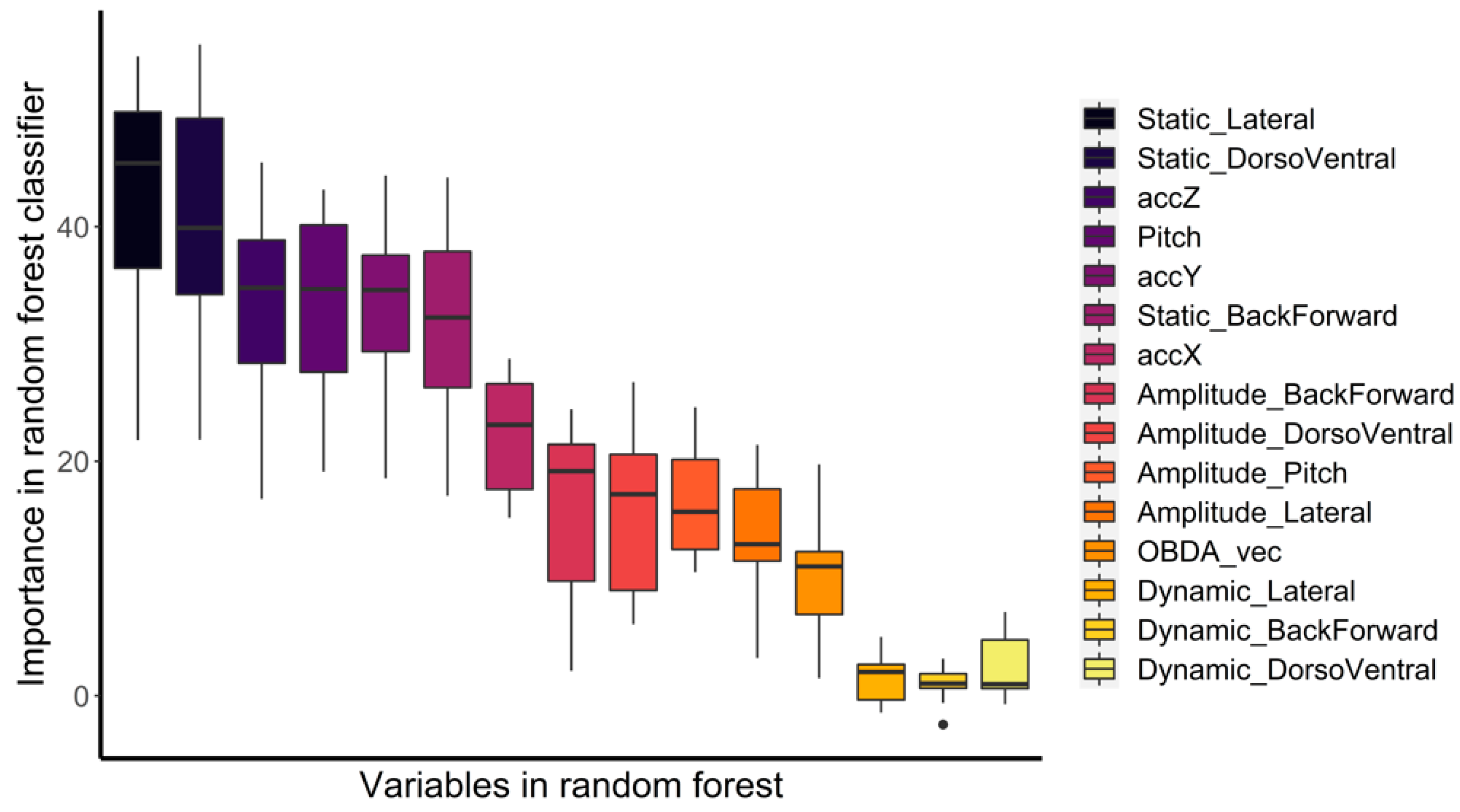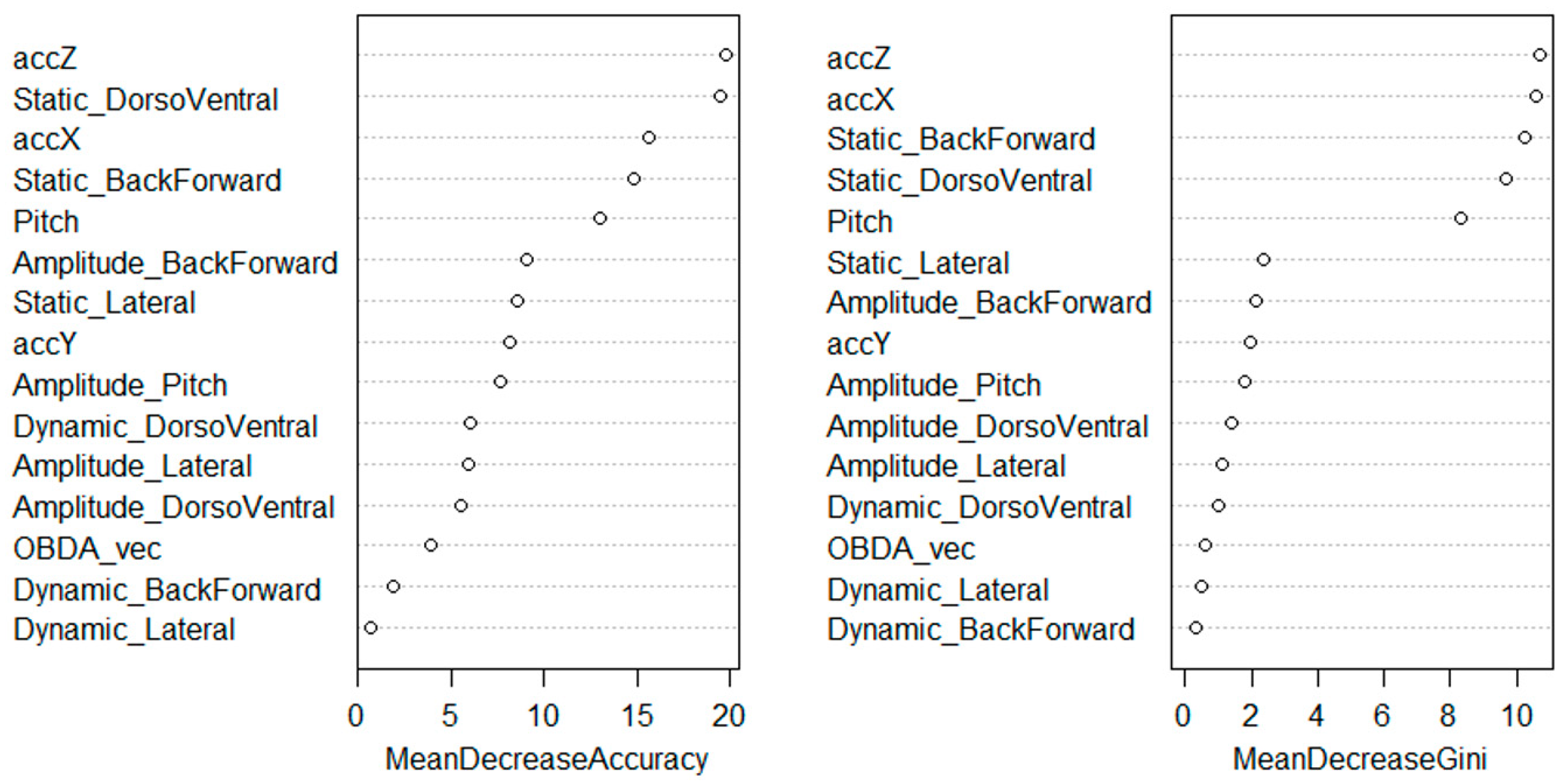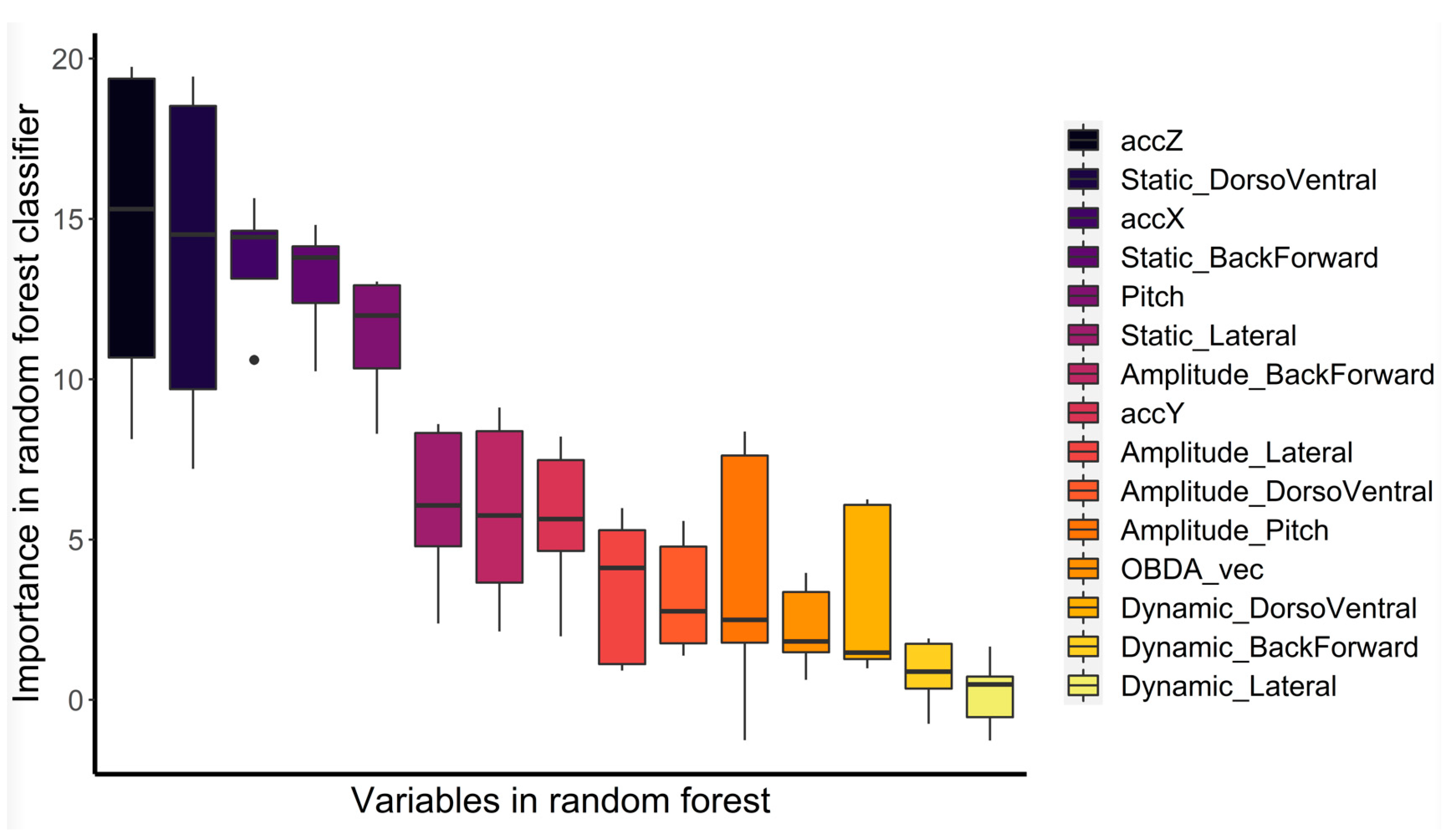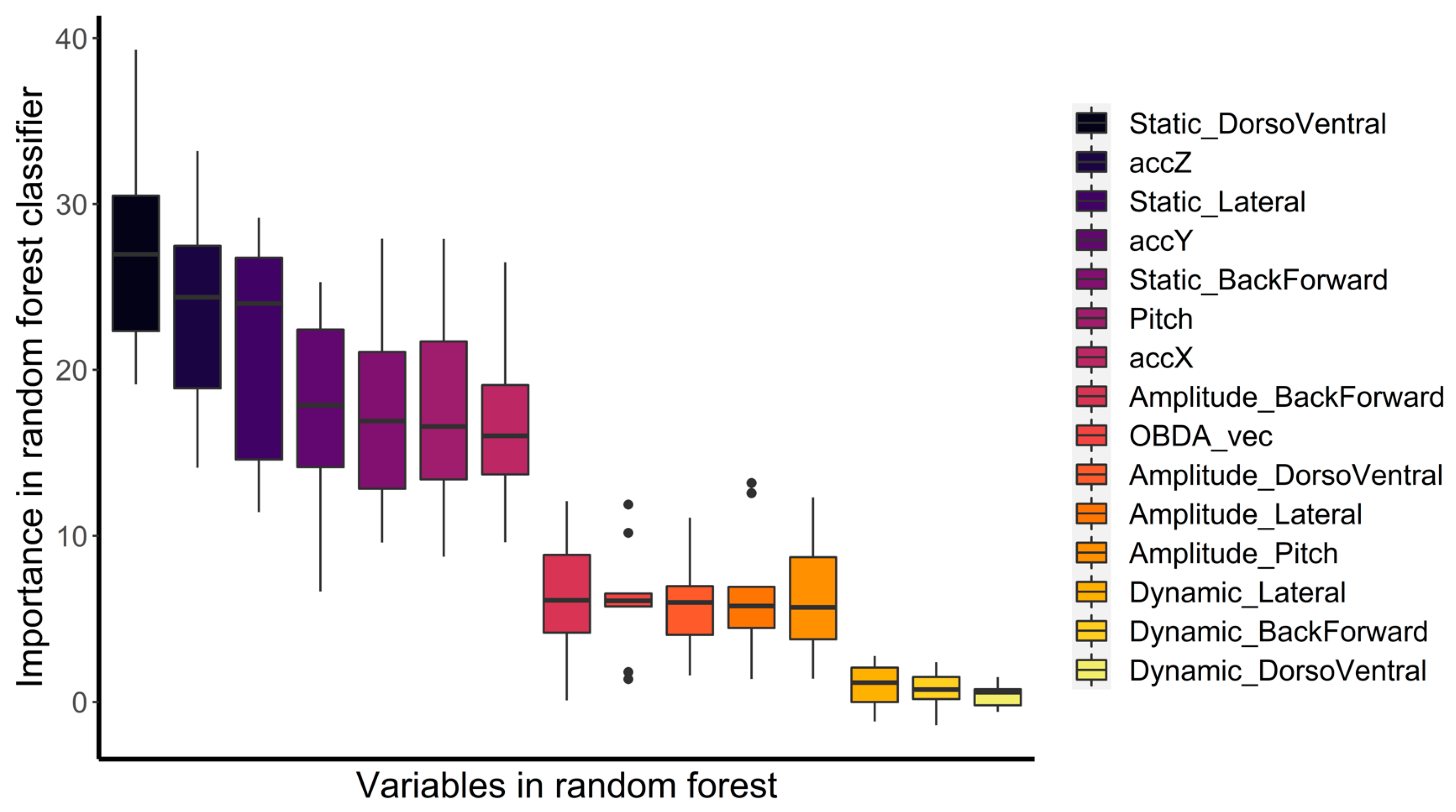Analysis of Accelerometer Data Using Random Forest Models to Classify the Behavior of a Wild Nocturnal Primate: Javan Slow Loris (Nycticebus javanicus)
Abstract
:1. Introduction
2. Materials and Methods
2.1. Field Methods
2.2. Materials
2.3. Data Analysis
“a classifier consisting of a collection of tree-structured classifiers {h(x,k), k = 1,…} where the {k} are independent identically distributed random vectors and each tree casts a unit vote for the most popular class at input x”[58]
3. Results
3.1. Locomotive Behaviors
3.2. Feeding Behaviors
3.3. Resting Behaviors
4. Discussion
5. Conclusions
Author Contributions
Funding
Institutional Review Board Statement
Informed Consent Statement
Data Availability Statement
Conflicts of Interest
Appendix A
References
- Cooke, S.J.; HInch, S.G.; Wikelski, M.; Andrews, R.D.; Kuchel, L.J.; Wolcott, T.G.; Butler, P.J. Biotelemetry: A mechanistic approach to ecology. Trends Ecol. Evol. 2004, 19, 334–343. [Google Scholar] [CrossRef] [PubMed]
- Kooyman, G.L. Genesis and evolution of bio-logging devices: 1963–2002. Mem. Natl. Inst. Polar Res. Spec. Issue 2004, 58, 15–22. [Google Scholar]
- Boyd, I.L.; Kato, A.; Ropert-Coudert, Y. Bio-logging science: Sensing beyond the boundaries. Mem. Natl. Inst. Polar Res. Spec. Issue 2004, 58, 1–14. [Google Scholar]
- Altmann, J. Observational study of behavior: Sampling methods. Behavior 1974, 49, 227–266. [Google Scholar] [CrossRef]
- Isbell, L.A.; Young, T.P. Human presence reduces predation in a free-ranging vervet monkey population in Kenya. Anim. Behav. 1993, 45, 1233–1235. [Google Scholar] [CrossRef]
- Jack, K.M.; Lenz, B.B.; Healan, E.; Rudman, S.; Schoof, V.A.M.; Fedigan, L. The effects of observer presence on the behavior of Cebus capucinus in Costa Rica. Am. J. Primatol. 2008, 70, 490–494. [Google Scholar] [CrossRef]
- Crofoot, M.C.; Lambert, T.D.; Kays, R.; Wikelski, M.C. Does watching a monkey change its behavior? Quantifying observer effects in habituated wild primates using automated radiotelemetry. Anim. Behav. 2010, 80, 475–480. [Google Scholar] [CrossRef]
- Hawkes, L.A.; Fahlman, A.; Sato, K. Introduction to the theme issue: Measuring physiology in free-living animals. Philos. Trans. R. Soc. B 2021, 376, 20200210. [Google Scholar] [CrossRef]
- Yoda, K. Advances in bio-logging techniques and their application to study navigation in wild seabirds. Adv. Robot. 2019, 33, 108–117. [Google Scholar] [CrossRef]
- Rothwell, E.S.; Bercovitch, F.B.; Andrews, J.R.M.; Anderson, M.J. Estimating daily walking distance of captive African elephants using an accelerometer. Zoo Biol. 2011, 30, 579–591. [Google Scholar] [CrossRef]
- Rushen, J.; Chapinal, N.; De Pasille, A.M. Automated monitoring of behavioral-based animal welfare indicators. Anim. Welf. UFAW J. 2012, 21, 339–350. [Google Scholar] [CrossRef]
- Whitham, J.C.; Miller, L.J. Using technology to monitor and improve zoo animal welfare. Anim. Welf. 2016, 25, 395–409. [Google Scholar] [CrossRef]
- Nekaris, K.A.I.; Campera, M.; Chimienti, M.; Murray, C.; Balestri, M.; Showell, Z. Training in the dark: Using target training for non-invasive application and validation of accelerometer devices for an endangered primate (Nycticebus javanicus). Animals 2022, 12, 411. [Google Scholar] [CrossRef]
- Nams, V. Combining animal movements and behavioral data to detect behavioral states. Ecol. Lett. 2014, 17, 1228–1237. [Google Scholar] [CrossRef] [PubMed]
- Fehlmann, G.; O’Riain, M.J.; Hopkins, P.W.; O’Sullivan, J.; Holton, M.D.; Shephard, E.L.C.; King, A.J. Identification of behaviors from accelerometer data in a wild social primate. Anim. Biotelem. 2017, 5. [Google Scholar] [CrossRef]
- Leos-Barajas, V.; Photopoulou, T.; Langrock, R.; Patterson, T.A.; Yuuki, Y.W.; Murgatroyd, M.; Papastamatiou, Y.T. Analysis of animal accelerometer data using hidden Markov models. Methods Ecol. Evol. 2017, 8, 161–173. [Google Scholar] [CrossRef]
- Gleiss, A.C.; Jorgensen, S.J.; Liebsch, N.; Sala, J.E.; Norman, B.; Hays, G.C.; Quintana, F.; Frundy, E.; Campagna, C.; Trites, A.W.; et al. Convergent evolution in locomotory patterns of flying and swimming animals. Nat. Commun. 2011, 2, 352. [Google Scholar] [CrossRef]
- Brown, D.D.; Kays, R.; Wikelski, M.; Wilson, R.; Klimley, A.P. Observing the unwatchable through acceleration of animal behavior. Anim. Biotelem. 2013, 1, 20. [Google Scholar] [CrossRef]
- Allaby, M. (Ed.) A Dictionary of Zoology, 3rd ed.; Oxford University Press: Oxford, UK, 2009. [Google Scholar]
- Yoda, K.; Sato, K.; Nizuma, Y.; Kurita, M.; Bost, C.A.; Le Maho, Y.; Naito, Y. Precise monitoring of porpoising behavior of Adélie penguins determined using acceleration data loggers. J. Exp. Biol. 1999, 202, 3121–3126. [Google Scholar] [CrossRef]
- Nakamura, I.; Goto, Y.; Sato, K. Ocean sunfish rewarm at the surface after deep excursions to forage for siphonophores. J. Anim. Ecol. 2015, 84, 590–603. [Google Scholar] [CrossRef]
- Duckworth, J.W. The difficulty of estimating population densities of nocturnal forest mammals from transect counts of animals. J. Zool. 1998, 246, 466–468. [Google Scholar] [CrossRef]
- Fernandez-Duque, E.; Erkert, H.G. Cathemerality and lunar periodicity of activity rhythms in owl monkeys of the Argentinian Chaco. Folia Primatol. 2006, 77, 123–138. [Google Scholar] [CrossRef] [PubMed]
- Papailiou, A.; Sullivan, E.; Cameron, J.L. Behaviors in rhesus monkeys (Macaca mulatta) associated with activity counts measured by accelerometer. Am. J. Primatol. 2008, 70, 185–190. [Google Scholar] [CrossRef] [PubMed]
- McFarland, R.; Hetem, R.S.; Fuller, A.; Mitchell, D.; Henzi, S.P.; Barrett, L. Assessing the reliability of biologger techniques to measure activity in a free-ranging primate. Anim. Behav. 2013, 85, 861–866. [Google Scholar] [CrossRef]
- Reinhardt, K.D.; Vyazovskiy, V.V.; Hernandez-Aguilar, R.A.; Imron, M.A.; Nekaris, K.A.I. Environment shapes sleep patterns in a wild nocturnal primate. Sci. Rep. 2019, 9, 9939. [Google Scholar] [CrossRef]
- Schneirla, T.C. The relationship between observation and experimentation in the field study of behavior. Ann. N. Y. Acad. Sci. 1950, 51, 1022–1044. [Google Scholar] [CrossRef]
- Caine, N.G. Unrecognized anti-predator behavior can bias observational data. Anim. Behav. 1990, 39, 195–197. [Google Scholar] [CrossRef]
- Cangacci, F.; Boitani, L.; Powell, R.A.; Boyce, M.S. Animal ecology meets GPS-based radiotelemetry: A perfect storm of opportunities and challenges. Philos. Trans. R. Soc. B Biol. Sci. 2010, 365, 2157–2162. [Google Scholar]
- Balestri, M. Ecology and Conservation of the Southern Woolly Lemur (Avahi meridionalis) in the Tsitongambarika Protected Area, South-Eastern Madagascar. Ph.D. Thesis, Oxford Brookes University, Oxford, UK, 2018. [Google Scholar]
- Campera, M. Ecological Flexibility and Conservation of Fleurette’s Sportive Lemur, Lepilemur fleuretae, in the Lowland Rainforest of Amapasy, Tsitongambarika Protected Area. Ph.D. Thesis, Oxford Brookes University, Oxford, UK, 2018. [Google Scholar]
- Reinhardt, K.D.; Campera, M.; Nekaris, K.A.I. Using accelerometers to measure nocturnal primate behavior. In Evolution, Ecology and Conservation of Lorises and Pottos; Cambridge University Press: Cambridge, UK, 2020; pp. 316–325. [Google Scholar]
- Hounslow, J.L.; Brewster, L.R.; Lear, K.O.; Guttridge, T.L.; Daly, R.; Whitney, N.M.; Gleiss, A.C. Assessing the effects of sampling frequency on behavioral classification of accelerometer data. J. Exp. Mar. Biol. Ecol. 2019, 512, 22–30. [Google Scholar] [CrossRef]
- McGowan, N.E.; Marks, N.J.; Maule, A.G.; Schmidt- Küntzel, A.; Marker, L.L.; Scantlebury, D.M. Categorising cheetah behaviour using tri-axial accelerometer data loggers: A comparison of model resolution and data logger performance. Mov. Ecol. 2022, 10, 7. [Google Scholar] [CrossRef]
- Jonsen, I.D.; Basson, M.; Bestley, S.; Bravington, M.V.; Patterson, T.A.; Pedersen, M.W.; Thomson, R.; Thygesen, U.H.; Wotherspoon, S.J. State-space models for bio-loggers: A methodological road map. Deep. -Sea Res. II 2013, 88–89, 34–46. [Google Scholar] [CrossRef]
- Ray, S. A quick review of machine learning algorithms. In Proceedings of the 2019 International Conference on Machine Learning, Big Data, Cloud and Parallel Computing (COMITCon 2019), Faridabad, India, 14–16 February 2019; pp. 35–39. [Google Scholar] [CrossRef]
- Alloghany, M.; Al-Jumeily, D.; Mustafina, J.; Hussain, A.; Aljaaf, A.; Alloghany, M.; Al-Jumeily, D.; Mustafina, J.; Hussain, A.; Aljaaf, A. A systematic review on supervised and unsupervised machine learning algorithms for data science. In Supervised and Unsupervised Learning for Data Science. Unsupervised and Semi-Supervised Learning; Springer: Cham, Switzerland, 2020; pp. 3–21. [Google Scholar]
- Wang, Y.; Nickel, B.; Rutishauser, M.; Bryce, C.M.; Williams, T.M.; Elkaim, G.; Wilmers, C.C. Movement, resting, and attack behaviors of wild pumas are revealed by tri-axial accelerometer measurements. Mov. Ecol. 2015, 3, 2. [Google Scholar] [CrossRef] [PubMed]
- Ladds, M.A.; Thompson, A.P.; Slip, D.J.; Hocking, D.P.; Harcourt, R.G. Seeing it all: Evaluating supervised machine learning methods for the classification of diverse otariid behaviours. PLoS ONE 2016, 11, e0166898. [Google Scholar] [CrossRef] [PubMed]
- Dentinger, J.E.; Börger, L.; Holton, M.D.; Jafari-Marandi, R.; Normand, D.A.; Smith, B.K.; Oppenheimer, S.F.; Strickland, B.K.; Wilson, R.P.; Street, G.M. A probabilistic framework for behavioral identification from animal-borne accelerometers. Ecol. Model. 2022, 464, 109818. [Google Scholar] [CrossRef]
- Resheff, Y.; Rotics, S.; Harel, R.; Spiegel, O.; Nathan, R. AcceleRater: A web application for supervised learning of behavioral modes from acceleration measurements. Mov. Ecol. 2014, 2, 27. [Google Scholar] [CrossRef]
- Sakamoto, K.Q.; Sato, K.; Ishizuka, M.; Watanuki, Y.; Takahashi, A.; Daunt, F.; Wanless, S. Can ethograms be automatically generated using body acceleration data from free-ranging birds? PLoS ONE 2009, 4, e5379. [Google Scholar] [CrossRef]
- Chimienti, M.; Cornulier, T.; Owen, E.; Bolton, M.; Davies, I.M.; Travis, J.M.J.; Scott, B.E. The use of an unsupervised learning approach for characterizing latent behaviors in accelerometer data. Ecol. Evol. 2016, 6, 727–741. [Google Scholar] [CrossRef]
- Nathan, R.; Spiegel, O.; Fortmann-Roe, S.; Harel, R.; Wikelski, M.; Getz, W.M. Using tri-axial acceleration data to identify behavioral modes of free-ranging animals: General concepts and tools illustrated for griffon vultures. Exp. Biol. 2012, 215, 986–996. [Google Scholar] [CrossRef]
- Tatler, J.; Cassey, P.; Prowse, T.A.A. High accuracy at low frequency: Detailed behavioral classification from accelerometer data. J. Exp. Biol. 2018, 221, jeb184085. [Google Scholar] [CrossRef]
- Al-Razi, A.; Hasan, S.; Ahmed, T.; Muzaffar, S. Home range, activity budgets and habitat use in the Bengal slow loris (Nycticebus bengalensis) in Bangladesh. In Evolution, Ecology and Conservation of Lorises and Pottos; Cambridge University Press: Cambridge, UK, 2020; pp. 193–203. [Google Scholar]
- Starr, C.; Nekaris, K.A.I.; Leung, L. Hiding from the moonlight: Luminosity and temperature affect activity of Asian nocturnal primates in a highly seasonal forest. PLoS ONE 2012, 7, e36396. [Google Scholar] [CrossRef]
- Nekaris, K.A.I. Extreme primates: Ecology and evolution of Asian lorises. Evol. Anthropol. 2014, 23, 177–187. [Google Scholar] [CrossRef] [PubMed]
- Rode-Margono, E.J.; Nekaris, K.A.I. Impact of climate and moonlight on a venomous mammal, the Javan slow loris (Nycticebus javanicus Geoffroy, 1812). Contrib. Zool. 2014, 83, 217–225. [Google Scholar] [CrossRef]
- Nekaris, K.A.I.; Handby, V.; Campera, M. Impact of weather conditions, seasonality and moonlight on the use of artificial canopy bridges by nocturnal arboreal mammals. Biodivers. Conserv. 2021, 30, 3633–3645. [Google Scholar] [CrossRef]
- Pliosungnoen, M.; Gale, G.; Savini, T. Density and microhabitat use of Bengal slow loris in primary forest and non-native plantation forest. Am. J. Primatol. 2010, 72, 1108–1117. [Google Scholar] [CrossRef] [PubMed]
- Nekaris, K.A.I.; Poindexter, S.; Reinhardt, K.; Sigaud, M.; Cabana, F.; Wirdateti, W.; Nijman, V. Coexistence between Javan slow lorises (Nycticebus javanicus) and humans in a dynamic agroforestry landscape in West Java, Indonesia. Int. J. Primatol. 2017, 38, 303–320. [Google Scholar] [CrossRef]
- Biro Pusal Statistik (BPO). Estates Area by Crop. 2022. Available online: https://www.bps.go.id/indicator/54/1847/1/luas-tanaman-perkebunan-besar-menurut-jenis-tanaman.html (accessed on 1 July 2023).
- Campera, M.; Budiadi, B.; Adinda, E.; Ahmad, N.; Balestri, M.; Hedger, K.; Imron, M.; Manson, S.; Nijman, V.; Nekaris, K.A.I. Fostering a wildlife-friendly program for sustainable coffee farming: The case of small-holder farmers in Indonesia. Land 2021, 10, 121. [Google Scholar] [CrossRef]
- Whitten, A.J.; Soeriaatmadja, R.E.; Afiff, S.A. The Ecology of Java and Bali, the Ecology of Indonesia (Vol. II); Periplus: Singapore, 1996. [Google Scholar]
- Flesher, K.M. The distribution, habitat use, and conservation status of three Atlantic Forest monkeys (Sapajus xanthosternos, Callicebus melanochir, Callithrix sp.) in an agroforestry/forest mosaic in Southern Bahia, Brazil. Int. J. Primatol. 2015, 36, 1172–1197. [Google Scholar] [CrossRef]
- Hending, D.; Andrianiaina, A.; Rakotomalala, Z.; Cotton, S. The use of vanilla plantations by lemurs: Encouraging findings for both lemur conservation and sustainable agroforestry in the Sava region, northeast Madagascar. Int. J. Primatol. 2018, 39, 141–153. [Google Scholar] [CrossRef]
- Breiman, L. Random Forests. Mach. Learn. 2001, 45, 5–32. [Google Scholar] [CrossRef]
- Cutler, A.; Cutler, D.R.; Stevens, J.R. Random Forests. In Ensemble Machine Learning; Springer: New York, NY, USA, 2012; pp. 157–175. [Google Scholar] [CrossRef]
- Nekaris, K.A.I. The Little Fireface Project: Community conservation of Asia’s slow lorises via ecology, education, and empowerment. In Ethnoprimatology; Springer: Cham, Switzerland, 2016; pp. 259–272. [Google Scholar]
- Nekaris, K.A.I.; Hedger, K.; Hathaway, A.; Adinda, E.; Ahmad, N.; Balestri, M.; Imrod, M.A.; Manson, S.; Nijman, V.; Campera, M. Local farmers’ attitudes towards artificial wildlife bridges in a fragmented agroforestry environment. Folia Primatol. 2022, 93, 317–324. [Google Scholar] [CrossRef]
- Reinhardt, K.D.; Wirdateti, W.; Nekaris, K.A.I. Climate mediated activity of the Javan slow loris (Nycticebus javanicus). AIMS Environ. Sci. 2016, 3, 249–260. [Google Scholar] [CrossRef]
- Nekaris, K.A.I.; Munds, R.A.; Pimley, E.R. Trapping, collaring, and monitoring the Lorisinae (Loris, Nycticebus) of Asia and Perodicticinae (Arctocebus, Perodicticus) of Africa. In Evolution, Ecology and Conservation of Lorises and Pottos; Cambridge University Press: Cambridge, UK, 2020; pp. 279–294. [Google Scholar]
- Snijders, L.; Weme, L.E.N.; de Goede, P.; Savage, J.L.; van Oers, K.; Naguib, M. Context-dependent effects of radio transmitter attachment on a small passerine. J. Avian Biol. 2017, 48, 650–659. [Google Scholar] [CrossRef]
- Shepard, E.L.C.; Wilson, R.P.; Quintana, F.; Laich, A.G.; Liebsch, N.; Albareda, D.A.; Halsey, L.G.; Gleiss, A.; Morgan, D.T.; Myers, A.E.; et al. Identification of animal movement patterns using tri-axial accelerometry. Endanger. Species Res. 2008, 10, 47–60. [Google Scholar] [CrossRef]
- Campbell, H.A.; Gao, L.; Bidder, O.R.; Hunter, J.; Franklin, C.E. Creating a behavioral classification module for acceleration data: Using a captive surrogate for difficult to observe species. J. Exp. Biol. 2013, 216, 4501–4506. [Google Scholar]
- Dickinson, E.R.; Twining, J.P.; Wilson, R.; Stephens, P.A.; Westander, J.; Marks, N.; Scantlebury, D.M. Limitation of using surrogates for behaviour classification of accelerometer data: Refining methods using random forest models in caprids. Mov. Ecol. 2021, 9, 28. [Google Scholar] [CrossRef]
- Campera, M.; Balestri, M.; Chimienti, M.; Nijman, V.; Nekaris, K.A.I.; Donati, G. Temporal niche separation between the two ecologically similar nocturnal primates Avahi meridionalis and Lepilemur fleuretae. Behav. Ecol. Soc. Biol. 2019, 73, 55. [Google Scholar] [CrossRef]
- Costantini, D.; Sebastiano, M.; Gossens, B.; Stark, D.J. Jumping in the night: An investigation of the leaping activity of the Western tarsier (Cephalopachus bancanus borneanus) using accelerometers. Folia Primatol. 2017, 88, 46–56. [Google Scholar] [CrossRef]
- Chimienti, M.; van Beest, F.M.; Beumer, L.T.; Desforges, J.-P.; Hansen, L.H.; Stelvig, M.; Schmidt, N.M. Quantifying behavior and life-history events of an Arctic ungulate from year-long continuous accelerometer data. Ecosphere 2021, 12, e03565. [Google Scholar] [CrossRef]
- Watanabe, Y.Y.; Papastamatiou, Y.P. Biologging and biotelemetry: Tools for understanding the lives and environments of marine animals. Annu. Rev. Anim. Biosci. 2023, 11, 247–267. [Google Scholar] [CrossRef]
- Bradshaw, C.J.; Hindell, M.A.; Sumner, M.D.; Michael, K.J. Relating behavioral signals derived from dataloggers to foraging success models for Southern elephant seals. In International Symposium on Bio-Logging Science; National Institute of Polar Research: Tokyo, Japan, 2003; pp. 17–21. [Google Scholar]
- Bograd, S.J.; Block, B.A.; Costa, D.P.; Godley, B.J. Biologging technologies: New tools for conservation. Introduction. Endanger. Species Res. 2010, 10, 1–7. [Google Scholar] [CrossRef]
- Davies, T.E.; Carneiro, A.P.; Tarzia, M.; Wakefield, E.; Hennicke, J.C.; Frederiksen, M.; Hansen, E.S.; Campos, B.; Hazin, C.; Lascelles, B.; et al. Multispecies tracking reveals a major seabird hotspot in the North Atlantic. Conserv. Lett. 2021, 14, e12824. [Google Scholar] [CrossRef]
- Kleanthous, N.; Hussain, A.; Khan, W.; Sneddon, J.; Liatsis, P. Deep transfer learning in sheep activity recognition using accelerometer data. Expert Syst. Appl. 2022, 207, 117925. [Google Scholar] [CrossRef]
- Jeantet, L.; Dell’Amico, F.; Forin-Wiart, M.A.; Coutant, M.; Bonola, M.; Etienne, D.; Gresser, J.; Regis, S.; Lecerf, N.; Lefebvre, F.; et al. Combined use of two supervised learning algorithms to model sea turtle behaviours from tri-axial acceleration data. J. Exp. Biol. 2018, 221, jeb177378. [Google Scholar] [CrossRef] [PubMed]








| Behavior | Abbreviation | Description |
|---|---|---|
| Alert | al | Remain stationary as in “rest” but active observation of environment or observer |
| Explore | ex | Meandering movement associated with looking for food or exploring the habitat |
| Feeding | fe | Consumption of a food item |
| Travel | tr | Continuous, directed movement from one location to another |
| Groom | gr | Autogroom, lick, or use tooth comb on own fur |
| Rest | re | Remain stationary, often with body hunched, eyes open |
| Posture | Abbreviation | Description |
|---|---|---|
| Sit | si | Remain stationary with body hunched and head erect |
| Stand | st | Remain stationary supported on all fours, limbs extended |
| Horizontal suspension 1 | H1 | Hanging from one foot |
| Horizontal suspension 2 | H2 | Hanging from two feet or bipedal standing |
| Horizontal suspension 3 | H3 | Hanging from three feet |
| Horizontal suspension 4 | H4 | Hanging from four feet |
| Vertical suspension 2 | V2 | Hanging towards the side of a support with 2 feet (e.g., when foraging or observing) |
| Vertical suspension 3 (up or down) | V3u V3d | Hanging towards the side of a support with 3 feet, either facing upwards or downwards |
| Vertical suspension 4 (up or down) | V4u V4d | Hanging towards the side of a support with 4 feet, either facing upwards or downwards |
| Locomotion | Abbreviation | Description |
|---|---|---|
| Walk | wa | Quadrupedal walking on 0° to 45° support |
| Racewalk | rw | Fast quadrupedal walking on 0° to 45° support |
| Suspensory walk | sw | Locomoting while hanging on 0° to −45° support |
| Bridge | bg | Climbing from one support to the next (trunk or branches of same or different trees) stretching over a gap of more than 15 cm |
| Climb up | cu | Moving upwards on +/−45° to +/−90° support |
| Climb down | cd | Moving downwards on +/−45° to +/−90° support |
| Climb horizontally | ch | Moving horizontally through 0° to +/−45° support |
| Accelerometer Variables | ||
|---|---|---|
| AccX | AccY | AccZ |
| Static_DorsoVentral | Static_Lateral | Static_BackForward |
| Amplitude_DorsoVentral | Amplitude_Lateral | Amplitude_BackForward |
| Dynamic_DorsoVentral | Dynamic_Lateral | Dynamic_BackfForward |
| Pitch | ODBA_vec | Amplitude_Pitch |
| Behavior | Prediction Accuracy (%) | Main Confusing Behavior(s) (% Error) | Most Important Variables in Random Forest Classifier | ||
|---|---|---|---|---|---|
| 1st Variable | 2nd Variable | 3rd Variable | |||
| ex_bg | 85.72 | ex_cd (11.9) | Static_Lateral | Static_DorsoVentral | accY |
| ex_cd | 94.4 | tr_cu; tr_wa (1.3) | Static_DorsoVentral | Static_Lateral | accZ |
| ex_ch | 77.42 | tr_cd (12.9) | Static_DorsoVentral | Static_Lateral | accY |
| ex_cu | 94.32 | tr_bg (1.9) | Static_DorsoVentral | Static_Lateral | accZ |
| ex_wa | 81.63 | ex_cd; ex_cu (9.18) | Static_DorsoVentral | accZ | accY |
| tr_bg | 82.44 | ex_cd (9.16) | Static_Lateral | Static_DorsoVentral | Pitch |
| tr_cd | 86.86 | ex_cd; tr_cu (2.85) | Static_Lateral | Static_DorsoVentral | Pitch |
| tr_cu | 94.12 | ex_cu; tr_bg (1.96) | Static_DorsoVentral | Static_Lateral | accZ |
| tr_rw | 83.34 | ex_cd (16.6) | Static_DorsoVentral | Static_Lateral | Pitch |
| tr_sw | 86.57 | ex_cu (8.95) | Static_Lateral | Static_DorsoVentral | Pitch |
| tr_wa | 74.08 | ex_cd (19.75) | Static_DorsoVentral | Static_Lateral | Pitch |
| Behavior | Prediction Accuracy (%) | Main Confusing Behavior (% Error) | Most Important Variables in Random Forest Classifier | ||
|---|---|---|---|---|---|
| 1st Variable | 2nd Variable | 3rd Variable | |||
| Fe_h3 | 100 | Na | accZ | Static_DorsoVentral | accX |
| Fe_h4 | 90.9 | Fe_v2 (9.09) | accX | Static_BackForward | Pitch |
| Fe_v2 | 93.75 | Fe_h4 (6.25) | accZ | accX | Static_DorsoVentral |
| Behavior | Prediction Accuracy (%) | Main Confusing Behavior(s) (% Error) | Most Important Variables in Random Forest Classifier | ||
|---|---|---|---|---|---|
| 1st Variable | 2nd Variable | 3rd Variable | |||
| Al_h2 | 100 | Na | accZ | Static_DorsoVentral | Static_Lateral |
| Al_h4 | 94.12 | Al_V4d (5.88) | Static_DorsoVentral | accZ | Amplitude_Lateral |
| Al_si | 100 | Na | Static_DorsoVentral | accZ | Static_Lateral |
| Al_st | 100 | Na | Static_DorsoVentral | accZ | Static_Lateral |
| Al_v4d | 100 | Na | Static_DorsoVentral | accZ | Static_BackForward |
| Gr_si | 100 | Na | Static_DorsoVentral | Static_Lateral | accZ |
| Re_sb | 100 | Na | Static_Lateral | Static_DorsoVentral | accY |
| Author | Species | Number of Subjects | Accelerometer Model | Sampling Frequency (Hz) | Overall Accuracy | 3 Most Important Variables | ||
|---|---|---|---|---|---|---|---|---|
| Present study | Javan slow loris (Nycticebus javanicus) | 1 (wild) | Technosmart Axy 5S | 25 | 94.60% | Static_Lateral | Static_DorsoVentral | Z axis |
| Nekaris et al. [13] | Javan slow loris (Nycticebus bengalensis) | 1 (captive) | Technosmart Axy 5S | 26 | 80.7% | Static_Lateral | Static_Dorsoventral | Y axis |
| Fehlmann et al. [15] | Chacma baboon (Papio ursinus) | 9 (wild) | Daily Diary sensor | 40 | 88.3% | Static X axis | Pitch | PSD1Z |
| Tatler et al. [45] | Dingo (Canis dingo) | 3 (captive) | LISD2H | 1 | 87% | Z axis | S.D. X | Mean X |
| Kleanthouse et al. [75] | Hebridian sheep (Ovis aries) | 8 (captive) | MetamorionR | 12.5 | 99.43% | -------------- Not given -------------- | ||
| Jeantet et al. [76] | Hawksbill and Green turtles (Eretmochelys imbricata and Chelonia mydas) | 2 (captive) | Wilog Acquisition Control Unit | 50 | 86.96% | Diff_Deep | Statix X axis | Min_VEDBA |
| Jeantet et al. [76] | Loggerhead turtle (Caretta caretta) | 1 (captive) | Wilog Acquisition Control Unit | 51 | 79.49% | Diff_Deep | Pitch | Static X axis |
Disclaimer/Publisher’s Note: The statements, opinions and data contained in all publications are solely those of the individual author(s) and contributor(s) and not of MDPI and/or the editor(s). MDPI and/or the editor(s) disclaim responsibility for any injury to people or property resulting from any ideas, methods, instructions or products referred to in the content. |
© 2023 by the authors. Licensee MDPI, Basel, Switzerland. This article is an open access article distributed under the terms and conditions of the Creative Commons Attribution (CC BY) license (https://creativecommons.org/licenses/by/4.0/).
Share and Cite
Hathaway, A.; Campera, M.; Hedger, K.; Chimienti, M.; Adinda, E.; Ahmad, N.; Imron, M.A.; Nekaris, K.A.I. Analysis of Accelerometer Data Using Random Forest Models to Classify the Behavior of a Wild Nocturnal Primate: Javan Slow Loris (Nycticebus javanicus). Ecologies 2023, 4, 636-653. https://doi.org/10.3390/ecologies4040042
Hathaway A, Campera M, Hedger K, Chimienti M, Adinda E, Ahmad N, Imron MA, Nekaris KAI. Analysis of Accelerometer Data Using Random Forest Models to Classify the Behavior of a Wild Nocturnal Primate: Javan Slow Loris (Nycticebus javanicus). Ecologies. 2023; 4(4):636-653. https://doi.org/10.3390/ecologies4040042
Chicago/Turabian StyleHathaway, Amanda, Marco Campera, Katherine Hedger, Marianna Chimienti, Esther Adinda, Nabil Ahmad, Muhammed Ali Imron, and K. A. I. Nekaris. 2023. "Analysis of Accelerometer Data Using Random Forest Models to Classify the Behavior of a Wild Nocturnal Primate: Javan Slow Loris (Nycticebus javanicus)" Ecologies 4, no. 4: 636-653. https://doi.org/10.3390/ecologies4040042
APA StyleHathaway, A., Campera, M., Hedger, K., Chimienti, M., Adinda, E., Ahmad, N., Imron, M. A., & Nekaris, K. A. I. (2023). Analysis of Accelerometer Data Using Random Forest Models to Classify the Behavior of a Wild Nocturnal Primate: Javan Slow Loris (Nycticebus javanicus). Ecologies, 4(4), 636-653. https://doi.org/10.3390/ecologies4040042






